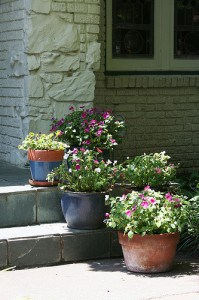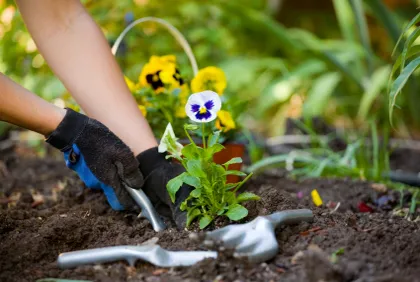The focal point of most Gainesville front yard landscaping is the entryway. Landscaping Gainesville plants and design around the entry way are more scrutinized, viewed more closely, and receive more attention than almost any other area of the yard. This is the area where specimen plants will be noticed. It is an area that, if budgets are tight, some annual flowers or more interesting seasonal color can be added. Create an interesting landscape to delight your guests and welcome yourself home from a long day away.
Here are some tips for landscaping the entryway in the front yard:
Do NOT Use Poisonous Plants
It might seem like a bit of a bummer to start off with what NOT to use, but for an entry garden, poisonous plants are a big no-no. Many commonly used landscape plants are highly poisonous—so much so that ingesting one leaf or berry is enough to make a person seriously ill or even cause death. Here are some plants to avoid at all costs:
• Oleander
• Castor bean
• Daphne (Unless it is well-hidden-it can practically grow under other shrubs, so it is possible to hide it. The fragrance is heavenly, the poisonous berries, not so much.)
• Sago palm
• Yew
There are many other poisonous plants, but few are used so frequently as specific landscape plants as those mentioned above. Yews are some of the most common foundation plantings, especially in landscape plantings around houses built in the 1970s and early 1980s. The leaves are poisonous, as is the center of the fruits, which are bright red and could tempt children to eat them.
Do use Fragrant Plants
One of the plants mentioned above, daphne, has one of the most pleasant fragrances of any ornamental plant. It is also poisonous, and very difficult to grow. You can generally tell if the daphne is going to be happy where it is, because if it is not, it simply won’t grow at all. There are other deliciously scented Gainesville plants that you can grow in place of the daphne, though. Here’s a list:
• Gardenia
• Knockout roses
• Fragrant tea olive
• Sweet Viburnum
Society Garlic (some love and some hate)
• Dianthus

Select several plants with fragrance, each of which blooms at a different time of the year, and then you will greet your guests with sweet perfume each time they are on your doorstep.
Don’t Plant Shrubs too Close to the Door
This is a good safety rule of thumb. That does not mean that you have to forsake shrubs entirely in your entry Gainesville landscape planting, but you do not want to plant any shrubs tall enough to obscure the view between your driveway or sidewalk and your door. At night, even with porch lights and other outdoor lighting, you need to be able to see a clear and unoccupied path to the door.
Do Use Outdoor Lighting
Many homeowners miss out on using dramatic outdoor lighting near their entry. There is a good way and a not so good way to use this type of lighting. Have you ever been to a friend’s house at night, stepped on the porch, and turned around to make sure that you locked your car, only to be blinded by a spotlight pointing straight up at the front door, and because you are standing in front of the front door, straight at you? If so, then you will understandably have an interest in creatively using outdoor lighting that promotes aesthetics and safety near the entryway.
Instead of uplighting your doors or windows, consider uplighting trees and plants around the entry. Ornamental grasses and river birches, in particular, look beautiful when lit from below. Other trees with fine-textured leaves are also pretty. Plants with thinner leaves look best because they do not completely reflect the light down from their leaves, but allow the light to shine through it, producing a kind of glow.
Do not Stuff Every Specimen Plant you have next to your Front Door
Specimen plants are specimens because they are rare or infrequently used. Planting too many of the same kind of odd looking plants creates visual fatique. Select one or two specimen trees or shrubs, and surround them with more neutral choices. For example, you could have a few specimen conifers, and a backdrop of ornamental grasses, or broad-leafed shrubs like rhododendrons behind. This will ensure that your specimens stand out. Also do this with perennials or annuals. If you have a gorgeous bleeding heart plant, surround it with iris, a plant that contrasts in form and texture but is leafed out at the same time as the bleeding heart.
Do Aim for Year-Round Interest
Because you walk in and out of your entryway all year, you will want to incorporate a mix of evergreen and deciduous trees, shrubs, annuals, perennials and bulbs. Here’s a nice blend of plants that will provide year-round color:
• Serviceberry (small tree)
• Coneflower (perennial)
• Variegated Dianthus (perennial)
• Ornamental grass (perennial)
• Winterberry (shrub)
• Agapanthus (bulb)
• Daffodil (bulb)
• Forget-me-not (perennial)
• Zinnia (annual)
The entry landscape is one area that should be planted and maintained year-round.
Do Plant Containers for the Entry Landscape

In addition to adding summer annual Gainesville flowers, container plantings at the entry add a splash of color and easy changes to the entry landscape without major excavation. Container plantings at the entry have to look nice on a scale with the door, porch or other architectural focal points at the entry, so good entry containers are generally larger than containers placed on a deck, or in the garden. To limit the number of plants you have to change from season to season, create a container with a small tree or shrub as the anchor. Then, add some perennials with evergreen leaves, such as coral bells or Lenten rose. Next, add annual color and trailing vines. You can always replace the annuals, or add some lights for winter interest.
Everyone who visits you will pass through your entry garden. Make sure it is welcoming and interesting by incorporating a variety of plants, with year-round color that complement your house.


